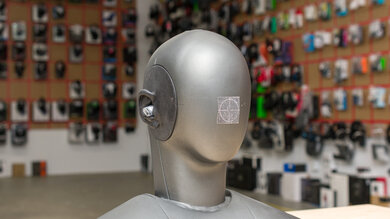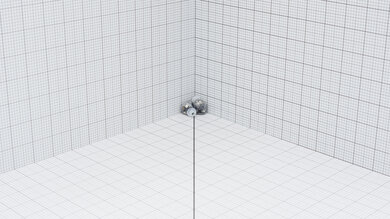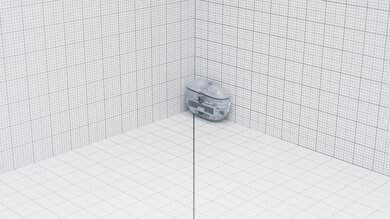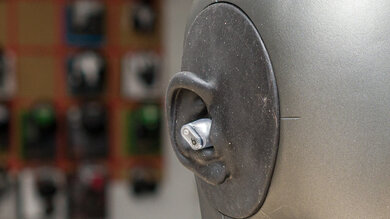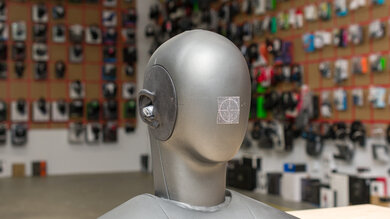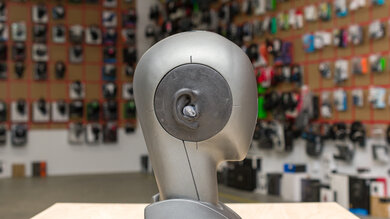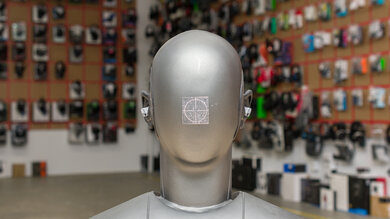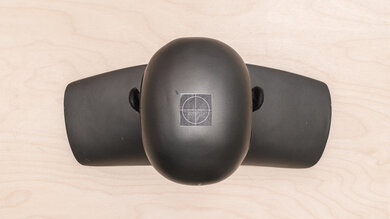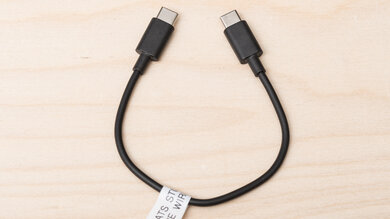The Beats Studio Buds + True Wireless are the next generation of the Beats Studio Buds True Wireless. While they look similar to their predecessor, these sleek buds come in a retro transparent colorway in addition to opaque colors like black and ivory. While well-built, these buds sit in the lower mid-range of Beats' lineup, so they lack some features found in their more expensive cousins, like an H1 or H2 chip for easy pairing with other devices in your Apple ecosystem or stability fins like those found on the Beats Powerbeats Pro Truly Wireless.
Our Verdict
The Beats Studio Buds Plus are alright for neutral sound. They have a somewhat neutral sound profile with a touch of extra treble, and their bass is thumpy and punchy without being muddy. However, the overemphasis in the high-mid to treble regions makes vocals and instruments sound harsh. They don't have any sound customization features to help you adjust their sound to your liking, either. Since they're in-ear headphones, they create a passive soundstage that doesn't feel very immersive.
- Deliver audio consistently.
- No sound customization features.
The Beats Studio Buds Plus are very good for commute and travel. These noise cancelling buds do a very good job blocking out everything from the low rumbles of plane engines to the higher-pitched hum of AC units but are especially impressive at blocking out mid-range sounds like chatty passengers. With their ANC on, they last 7.5 hours continuously, and their carrying case holds an extra three charges if needed. Thanks to their small and lightweight design, they're also easy to take with you on the go.
- Very good noise isolation performance.
- Comfortable fit.
- No volume controls by default.
The Beats Studio Buds Plus are good for sports and fitness. These small and lightweight buds have a comfortable fit and are certified IPX4 for resistance against water splashes. But they lack stability fins and can fall out of your ear with intense movement, which isn't ideal if you're using them during a tough workout. You may need to readjust their fit during moderate movement to keep them from wiggling out of your ear. Their case isn't certified for water resistance, so don't bring that with you anywhere wet.
- Buds themselves have an IPX4 rating for water resistance.
- Comfortable fit.
- No volume controls by default.
The Beats Studio Buds + are decent for office use. Thanks to their ANC system, these comfortable buds can easily block out chatty coworkers. With their ANC on, they last 7.5 hours continuously, which may not be enough to get you through your whole day, but their carrying case holds an extra three charges if you need it. On the downside, these buds don't support multi-device pairing, so you can't stay connected to your PC and smartphone simultaneously.
- Very good noise isolation performance.
- Comfortable fit.
- No multi-device pairing.
- No volume controls by default.
The Beats Studio Buds Plus are Bluetooth-only headphones, and their latency on PCs is too high for gaming. However, they have lower latency on iOS and Android devices, which is good if you're into mobile gaming. They last over seven hours continuously and have a comfortable fit.
The Beats Studio Buds Plus are truly wireless earbuds; you can't use them wired.
The Beats Studio Buds + are acceptable for phone calls. Their integrated mic does a decent job of capturing your voice, but it has difficulty separating speech from noise. That means if you need to take calls from places like a busy office, your voice can be drowned out by noise around you. On the upside, these buds are equipped with an ANC system to help cut down a good amount of background sound, so you'll be able to hear anyone on the other end of the line.
- Very good noise isolation performance.
- Comfortable fit.
- Disappointing noise handling.
- No multi-device pairing.
Changelog
- Updated Jul 24, 2024: The Controls section has been updated to mention the Beats Solo Buds True Wireless.
- Updated Jul 15, 2024: We rewrote parts of this review for clarity and to bring it up-to-date. We also added some comparisons with other similar headphones.
- Updated Jun 30, 2023: Review published.
- Updated Jun 23, 2023: Early access published.
Check Price
Differences Between Sizes And Variants
The Beats Studio Buds Plus come in four color variants: 'Black/Gold', 'Cosmic Silver,' 'Ivory', and 'Transparent'. We tested the 'Transparent' model; you can see their label here. If you come across another variant of these headphones, please let us know in the forums, and we'll update our review.
Popular Headphones Comparisons
The Beats Studio Buds Plus are the next generation of the Beats Studio Buds True Wireless. These buds significantly improve upon their predecessor's ANC system, and while they don't cut down as much noise as the Apple AirPods Pro 2, they still do a very good job in this regard. Battery life also received an upgrade, which is great if you're always on the go and don't want to worry about recharging them often. However, like their predecessor, they still don't have an H1 chip for seamless pairing with Apple devices and lack sound customization features.
Check out our recommendations for the best wireless Bluetooth earbuds, the best noise cancelling earbuds, and best Beats headphones.
The Beats Studio Buds + True Wireless are the next generation of the Beats Studio Buds True Wireless. The Plus model offer a couple of upgrades over their predecessor, including a significantly better noise isolation performance and a longer-lasting continuous battery life.
The Beats Fit Pro True Wireless have a slight edge over the Beats Studio Buds + True Wireless. The Fit Pro have a more stable fit, support Apple's Spatial Audio feature for a more immersive audio experience, and have a better noise isolation performance. They also have an H1 chip for seamless pairing with your Apple devices. However, the Studio Buds + are more comfortable, come with one more silicone tip size in the box, and have a better overall battery performance.
The Apple AirPods Pro 2 are better in-ear headphones than the Beats Studio Buds + True Wireless. While both sets of buds are equally comfortable, Apple's are better built, their noise isolation performance is significantly better, and they have an H2 chip, so you can easily pair these buds with other devices in your Apple ecosystem. On the other hand, the Beats have a longer continuous battery life.
While the Beats Studio Buds + True Wireless and the Sony LinkBuds S Truly Wireless are similar in-ears, the Sony are better in a few respects. First, the Sony's ANC does a better job blocking out the sound of nearby conversations and AC hum. Secondly, their companion app has a graphic EQ and presets for customizing your sound. On the other hand, the Beats have a better mic and a brighter treble response by default, which you may prefer.
Test Results

The Beats Studio Buds Plus are the next generation of the Beats Studio Buds True Wireless noise cancelling earbuds. They're made of plastic and come in four color variants: 'Black/Gold,' 'Cosmic Silver,' 'Ivory,' and 'Transparent.' We tested the transparent version, which allows you to see the inner circuitry. The buds have a short stem design with the manufacturer's logo marking their control buttons on the side of each stem. Unlike their predecessor, they have three acoustic vents, which help improve their audio precision and lessen pressure on the inner ear.
These buds have a comfortable in-ear fit that doesn't put too much pressure on your ears. They come with four pairs of silicone ear tips, so it's easy to find a good fit. Using the controls doesn't push the buds deeper into your ear, either. The downside is that the buds stick out a bit from your ear.
These buds have easy-to-use physical controls. You push the manufacturer's logo on the stem of each bud to register commands. The button itself doesn't stick out as much as that of their predecessor, and there's a soft click to let you know when you've registered a command. There are also different tones to let you know when you're switching between ANC, transparency, and normal (no ANC) modes. However, like the Beats Solo Buds True Wireless, there are no volume controls by default on the buds. You have to assign the buttons to control this yourself via the companion app. If you do this, you'll lose out on the ANC controls.
On either bud:
- Single press: Plays and pauses audio. Also answers and ends calls.
- Double press: Skips the track forward.
- Triple press: Skips the track backward.
- Press and hold: By default, cycles between ANC, 'Transparency mode,' which mixes a little external noise in with your audio to let you better hear your environment, and both modes off. You can change this command via the companion app to activate voice assistant or volume controls.
These buds are very portable. They have a small and lightweight design that makes it easy to fit them into most pockets or bags without issue. You can also stow them in their charging case for hassle-free transportation.
The Beats Studio Buds Plus come with a good carrying case that is similar to their predecessor in design. While it seems sturdy enough, the plastic does not feel especially premium. There's a small light at the front of the case to let you know when it's charging and there's a pairing button inside the roof of the case.
The Beats Studio Buds Plus have good build quality. Their plastic design feels solid rather than premium, and they are certified IPX4 for resistance against splashes of water. While that makes them a good choice for outdoor activities, it would be best not to bring the case with you, as it lacks an IP rating and may get damaged if exposed to any amount of water.
The Beats Studio Buds + True Wireless have a decently stable fit. While they feel stable when first placed in your ears, you'll have to constantly readjust them after gentle movements if you want to keep a good fit. They can start to pop out with moderate-intensity movements, such as head shakes, and will fall out if you wear them during a tough workout.
The Beats Studio Buds + True Wireless have a somewhat neutral sound profile. They deliver enough low-to-mid-bass to give mixes ample thump, rumble, and boom, and the high-bass and low-mids are well-balanced, ensuring warmth without muddiness. However, a peak in the high-mid makes vocals and instruments sound harsh. Some peaks and dips in the treble region can leave sibilants and cymbals sounding alternately dull or harsh, depending on their pitch. They also don't have any sound customization features to help you adjust their default sound profile to suit your preferences.
We had some trouble getting the right bud to stay in place and form a good seal in our test rig's ear. This led to slightly different readings in the low-bass region for the left and right buds, but we don't expect you to face this problem.
The Beats Studio Buds Plus have impressive frequency response consistency. If you take the time to get a good fit, you'll get consistent bass and treble delivery with every wear. It's worth noting that we had trouble getting the right bud to form a good seal in our test rig's ears, causing deviations in the bass range, but we don't expect you to encounter this issue.
The Beats Studio Buds Plus have outstanding bass accuracy. While offering more bass than our target curve, their response is fairly flat throughout the entire bass region, so individual bass notes at specific pitches don't jump out in unnatural ways. Kicks and subby 808s have extra boom, and melodic basslines have a little extra body to help them cut through dense mixes. A little boost in the high-bass adds warmth without sounding muddy. In songs like Paul Simon's Slip Slidin' Away, the bass sounds full, but it never interferes with the fundamentals of Simon's vocals, which remain clear and present.
The Beats Studio Buds Plus's mid accuracy is decent. The low-mid is fairly flat, so vocals and instruments are present without being muddy in mixes. However, there's a peak in the response from the mid-mid onwards, which pushes vocals and instruments forward, occasionally making them harsh. In songs like Africa by TOTO, the extra mid- and high-mid makes vocals in the final chorus sound a little boxy and honky, especially compared to the guitar, which sounds noticeably further back in the mix.
The Beats Studio Buds Plus have very good treble accuracy. Some of the mid-range overemphasis mentioned above continues into the low-treble region, so while vocals are certainly present and articulate, they are also a touch harsh. The mid-treble region is also overemphasized compared to our target curve, so sibilants and cymbals are a little bright, but they don't completely dominate the mix. In songs with a lot of hi-hat action, like Roxanne by The Police, sibilants sound present throughout the track but aren't piercing.
The peaks and dips performance is good, meaning they generally follow their own sound profile well, but there are a couple of large peaks worth mentioning. A peak in the low-bass adds thump and boom, while a peak in the high-mid makes vocals and instruments sound relatively harsh. A couple of small dips in the low-treble and a peak in the mid-treble means vocals and instruments can be alternately dull or piercing, depending on their pitch.
Beats generally have good quality control and ergonomics, which helps ensure that their products have well-matched drivers. This is crucial for good imaging, as well-matched drivers ensure headphones can accurately place objects like instruments in the stereo image. But imaging varies between units.
Our unit's L/R drivers display some mismatch in group delay, phase, amplitude, and frequency response. The peaks in group delay and phase response mismatch shown in the graphs here are mostly due to the right bud popping out of our test rig's ear over time. However, some of that mismatch isn't due to our test rig: instruments in the low- and mid-bass, like boomy 808 kicks, do sound slightly panned to the right. The mid-range peak in phase response mismatch is also audible with real-life content. For example, the vocals in the song, Do I Wanna Know? by Arctic Monkeys don't sound properly placed in the mix. The mismatch also leaves audio in the center of the stereo field feeling a little hollow.
The Beats Studio Buds Plus have a bad passive soundstage performance, but that's to be expected from an in-ear design. Audio bypasses your outer ear, which must be activated to create a wide, immersive soundstage. As a result, their soundstage feels small and closed-off. Audio seems like it is coming from inside your head rather than speakers placed in the room around you.
The Beats Studio Buds Plus support Apple's Spatial Audio and Dolby Atmos via Apple Music, which can help create a more immersive audio experience. However, unlike the Apple AirPods Pro 2, you can't access these features via the iOS interface in order to use the functionality with any audio player you choose. You can only use it with apps that provide compatible media, like Apple Music, but you may need to purchase a separate subscription to access these services.
The weighted harmonic distortion performance is great. All frequencies fall within good limits, and the peak in the mid-treble range is inaudible. The result is clear and pure audio reproduction.
These are the settings used to test the Beats Studio Buds Plus. Our results are only valid when used in this configuration.
The Beats Studio Buds Plus' noise isolation performance is very good. Like their predecessor, they have active noise cancelling (ANC), but these do a significantly better job of blocking out background noise than the Beats Studio Buds True Wireless. They are especially good at cutting down on mid-range sounds like office chatter. The ANC makes the biggest difference in the low end, where it does a much better job blocking out the rumble of bus engines than the headphones do passively, without ANC on. However, while the earbuds still do a solid job blocking out higher-pitched sounds like AC hum, most of this is achieved passively via the seal of the silicone ear tips in your ear canal. Turning ANC on doesn't reduce those sounds much further.
The Beats Studio Buds Plus have excellent leakage performance. Most of the the leakage is concentrated in the treble range, so if others are able to hear your audio, it will sound fairly thin. That said, even if you listen to your favorite tunes at high volumes, it's unlikely anyone around you will be bothered by it.
The Beats Studio Buds + True Wireless have an integrated mic with decent recording quality. Speech is clear but sounds dark as the mic captures little air or sparkle in the mid and high-treble ranges. Your voice will also sound a bit thin through this mic, as it captures little of the body and warmth characteristic of the high-bass region.
The mic's noise handling performance is disappointing. If you're taking a call in a noisy environment, the background noise is present and distracting when you're talking. Loud noises like a train passing will also overpower your voice, making it more difficult to understand what you're saying.
The Beats Studio Buds Plus' battery performance is okay. The manufacturer claims they last six hours continuously with ANC on at a volume of 50%. We measured well over seven hours with ANC on, but battery life varies depending on use and volume. If you turn the ANC off, the manufacturer advertises them to last up to nine hours, which is handy if you're trying to save every last drop of battery life. Their carrying case has three extra charges if you need it. You can also use one bud while the other charges.
The Beats app is passable. You can see a video of how it works on Android and iOS. It's a fairly limited app that doesn't have sound customization features like an EQ.
On the plus side, you can change how the buttons on each bud behave. You can change what happens when you press and hold each bud. By default, they cycle between ANC, transparency (which filters some external noise into your buds alongside ANC so that you can hear your surroundings better without taking the buds out of your ears), and normal modes, but they can also be assigned to control volume or activate a voice assistant. You can customize the controls for accepting or ending a call, choosing between single or double short presses on each bud. Finally, you can change whether the microphone on the left or right bud is used or whether the selection is made automatically by the headphones.
The app also allows you to rename your buds and register them for updates.
The Beats Studio Buds Plus have decent Bluetooth connectivity. Like their predecessor, they don't have an H1 chip for seamless, quick pairing with iOS devices, which is disappointing if you want to simultaneously keep your buds connected to your iPad and iPhone. While they have an audio switch feature, which allows you to transition from one audio source to another, this isn't true multi-device pairing as you won't stay connected to multiple devices at a time. Still, switching is easy and not disruptive.
These buds have high latency on PCs, but their latency is much lower on Android and iOS devices, which ensures that your audio and visuals stay in sync while streaming video. It's worth noting that some apps and devices compensate for latency differently.
You can connect these headphones to Bluetooth-enabled PCs and use their audio and mic capabilities simultaneously, but you can't connect them to your PC any other way.
These headphones come with a carrying case that holds three charges. It has a USB-C port for charging the case using the supplied UCB-C to USB-C cable. The case lacks wireless charging support.

